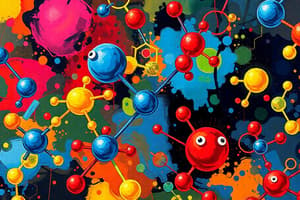Podcast
Questions and Answers
Which type of intermolecular force is responsible for determining the physical and chemical properties of nonpolar molecules?
Which type of intermolecular force is responsible for determining the physical and chemical properties of nonpolar molecules?
- Van der Waals forces (correct)
- Covalent bonds
- Ionic bonds
- Hydrogen bonding
What are London dispersion forces also known as?
What are London dispersion forces also known as?
- Ionic bonds
- Dipole-dipole interactions
- Instantaneous dipoles-induced dipoles (correct)
- Metallic bonds
Which of the following best describes intermolecular forces?
Which of the following best describes intermolecular forces?
- Forces acting between molecules (correct)
- Forces within the nucleus of an atom
- Forces maintaining the structure of a crystal lattice
- Forces holding atoms together in a molecule
Which type of intermolecular force involves the electrostatic forces between two polar molecules?
Which type of intermolecular force involves the electrostatic forces between two polar molecules?
What is the primary function of intermolecular forces in relation to the physical properties of substances?
What is the primary function of intermolecular forces in relation to the physical properties of substances?
Flashcards are hidden until you start studying
Study Notes
Intermolecular Forces
- London dispersion forces, also known as van der Waals forces, are responsible for determining the physical and chemical properties of nonpolar molecules.
- London dispersion forces are weak intermolecular forces that arise from temporary dipoles in nonpolar molecules.
- Intermolecular forces refer to the attractive and repulsive forces between molecules, which play a crucial role in determining the physical properties of substances.
- Dipole-dipole forces, a type of intermolecular force, involve the electrostatic forces between two polar molecules.
- The primary function of intermolecular forces is to influence the physical properties of substances, such as boiling point, melting point, and solubility.
Studying That Suits You
Use AI to generate personalized quizzes and flashcards to suit your learning preferences.




